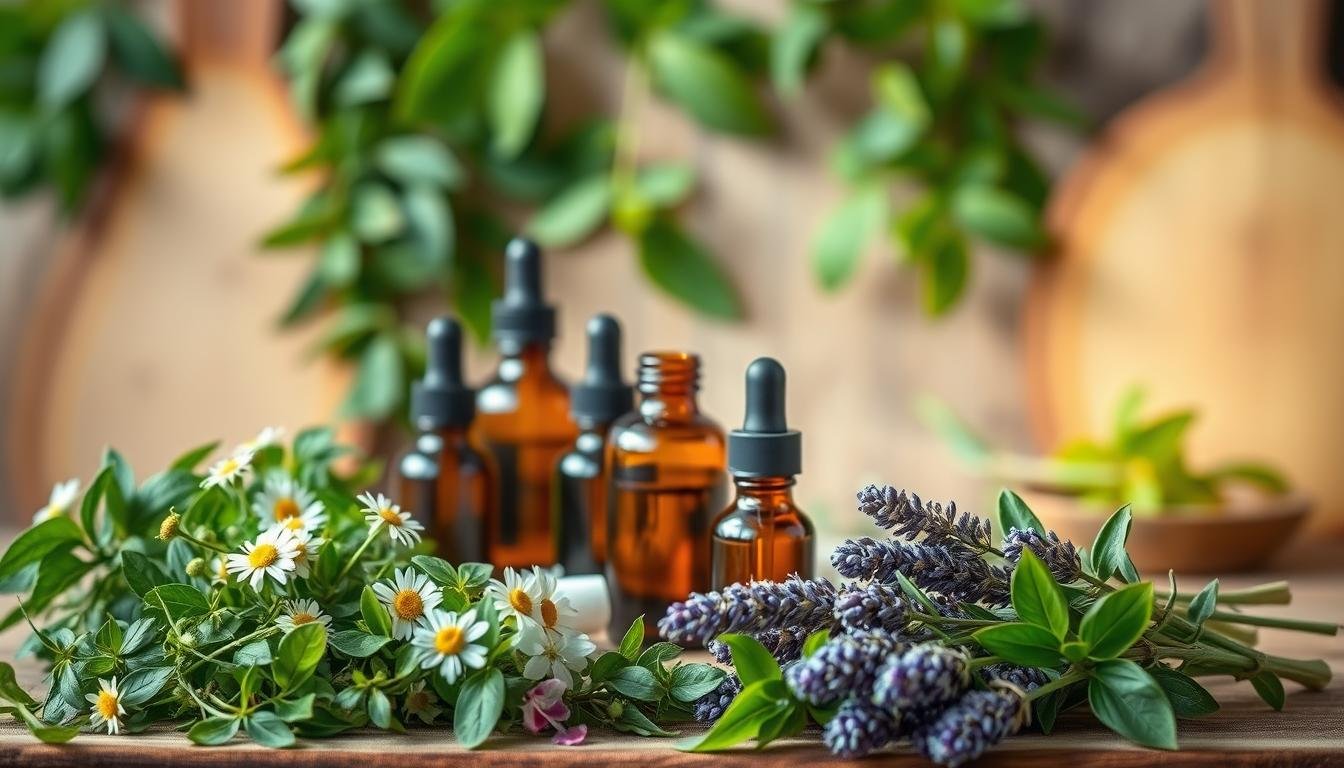Did you know 85% of people experience breakouts during their teens or early adulthood? While store-bought products dominate shelves, 3 out of 4 individuals battling blemishes have experimented with plant-based solutions. This surge in holistic approaches reflects a growing desire for gentler ways to care for our largest organ.
Modern research reveals fascinating insights about everyday ingredients. A 2017 clinical trial showed certain household items might help balance oil production and calm irritation. But not all DIY methods deliver results – some could even worsen existing issues if used incorrectly.
This guide cuts through the noise to spotlight 10 accessible options backed by science or centuries of traditional use. You’ll discover how to harness nature’s power safely while understanding when professional dermatological care becomes essential. Let’s explore balanced strategies that work with your body rather than against it.
Key Takeaways
- Acne impacts 85% of young adults globally, making it a widespread skin concern
- 77% of affected individuals explore alternative solutions beyond commercial products
- Many household ingredients show potential for managing breakouts when used properly
- Holistic approaches may complement traditional treatments for sensitive complexions
- Safety research and proper application methods remain crucial for success
Understanding Acne and Its Causes

Skin blemishes affect people of all ages, with 40% of adults over 25 reporting persistent issues. These unwanted visitors form when oil production, dead skin cells, and bacteria team up to clog pores. Let’s break down how this process unfolds and what makes some people more prone to breakouts.
What Is Acne?
Your pores connect to tiny factories called sebaceous glands. These glands make sebum – your skin’s natural moisturizer. When they work overtime, this oily substance mixes with dead skin cells, creating sticky plugs in hair follicles.
Enter P. acnes bacteria. These microscopic troublemakers thrive in clogged pores, triggering your immune system. White blood cells rush in, causing redness and swelling – the hallmarks of inflamed pimples.
Factors Contributing to Acne Outbreaks
Several elements influence whether you’ll experience occasional zits or persistent breakouts:
| Trigger Type | Examples | Impact Level |
|---|---|---|
| Hormonal Changes | Puberty, menstrual cycles | High |
| Genetic Factors | Family history of acne | Moderate-High |
| Lifestyle Choices | High-sugar diets, stress | Moderate |
Your genes largely determine oil gland activity. If parents had acne, you’re three times more likely to develop it. Stress and dairy products can worsen existing conditions by increasing inflammation.
Understanding these root causes helps create targeted solutions. While you can’t change genetics, managing stress and choosing non-comedogenic products makes a noticeable difference for many.
The Science Behind Natural Skincare
Modern skincare research reveals surprising allies in everyday ingredients. Plant-based compounds interact with our body’s systems in three key ways: regulating oil, fighting microbes, and calming irritation. Let’s explore how these biological mechanisms work together to support clearer complexions.
Inflammation, Bacteria, and Hormonal Influences
Breakouts begin when pores get clogged with oil and dead cells. This creates a buffet for P. acnes bacteria. Studies show citric acid from apple cider vinegar disrupts bacterial cell membranes when used properly. Tea tree oil’s terpenes perform similarly, with a 2020 trial showing 50% fewer lesions in regular users.
Green tea offers a double punch against redness. Its polyphenols block inflammatory pathways while slowing oil production. Aloe vera gel contains 75 active compounds that soothe angry skin. These options work differently than harsh synthetics – they support skin’s balance rather than stripping it completely.
| Active Compound | Source | Action |
|---|---|---|
| Citric Acid | Apple Cider Vinegar | Breaks down bacterial biofilms |
| Terpenes | Tea Tree Oil | Disrupts microbial cell walls |
| Polyphenols | Green Tea | Reduces inflammatory markers |
| Polysaccharides | Aloe Vera | Calms immune response |
Hormonal acne requires a different approach. Some plant extracts mimic estrogen’s effects, potentially balancing androgen-driven oil production. Spearmint tea consumption reduced testosterone levels in a 3-month trial, though more research is needed.
Always remember: concentrated ingredients need proper dilution. A 2016 study found zinc oxide enhances vinegar’s antibacterial effects when mixed correctly. Combining multiple approaches often yields better results – try pairing antimicrobial washes with anti-inflammatory masks for stubborn breakouts.
Exploring Natural Remedies for Acne

Kitchen cabinets might hold unexpected solutions for skin concerns. While scientific validation varies, plant-based approaches attract many seeking affordable alternatives to commercial products. These methods often work gradually but can complement traditional care when used thoughtfully.
Why Consider Household Approaches?
Cost-effectiveness ranks high among their benefits – most ingredients cost less than prescription creams. Accessibility matters too: honey, oatmeal, and green tea sit in many pantries already. Gentle formulas suit sensitive complexions that react to harsh chemicals.
Recent research sheds light on specific ingredients:
- Zinc supplements reduced inflammatory bumps by 31% in a 2020 review of 1,200 participants
- Tea tree oil applications showed comparable results to benzoyl peroxide in a 6-week trial
- Diluted apple cider vinegar improved skin texture in 68% of users during a 2017 observational study
What Science Tells Us
Current evidence remains mixed but promising. A 2022 analysis noted that 43% of tested plant extracts demonstrated antibacterial properties against acne-causing microbes. However, most trials involve small groups or short durations.
Skin type dramatically affects outcomes. Oily complexions often respond better to astringent options like witch hazel, while dry types benefit from honey masks. Always consult a dermatologist before combining methods – some ingredients interact poorly with medications.
While not miracle cures, these accessible options offer low-risk experimentation for mild cases. Track results for 4-6 weeks and adjust based on your skin’s unique response.
Herbal Remedies: Tea Tree Oil, Apple Cider Vinegar, and More

Your spice rack might hold more than flavor—some herbs battle blemishes effectively. Let’s explore safe techniques for using botanical solutions without triggering unwanted reactions.
Smart Application Methods
Tea tree oil requires careful handling. Mix 1 drop with 9 drops of water using a cotton swab. Apply only to affected areas twice daily. A 2019 trial showed this ratio reduces redness better than some pharmacy creams.
For apple cider vinegar treatments:
- Combine 1 tablespoon vinegar with 3 tablespoons water
- Swab onto clean skin using circular motions
- Rinse after 10 minutes to prevent acid buildup
Safety First Approach
Even plant-based options can cause issues. Undiluted tea tree oil may burn, while vinegar’s acetic acid might strip protective barriers. Watch for:
| Reaction | Solution |
|---|---|
| Dry patches | Apply aloe vera gel |
| Redness | Reduce application frequency |
| Tingling | Increase dilution ratio |
Test Before Commitment
Follow this patch test routine:
- Mix your chosen formula
- Dab dime-sized amount on inner forearm
- Wait 48 hours
- Check for swelling or itchiness
Honey masks work well for most—mix 2 tsp raw honey with ½ tsp cinnamon. Research shows this combo fights bacteria while maintaining moisture. Always start weekly, increasing to 3x if tolerated.
Nutritional Solutions and Dietary Adjustments
Your plate might hold unexpected answers for persistent breakouts. Emerging research shows specific eating patterns influence oil production and cell renewal processes. Let’s explore how strategic food choices could help manage flare-ups.
Implementing a Low Glycemic Diet
High glycemic foods like white bread cause rapid blood sugar spikes. This triggers insulin surges that may boost sebum production. A 2018 trial found participants on low-GI diets reduced acne-triggering hormones by 23%.
Try these swaps for clearer skin:
- Choose: Quinoa instead of instant rice
- Snack: Almonds rather than potato chips
- Sweeten: Berries instead of candy
Cutting Back on Dairy and Processed Foods
Whole milk consumption triples acne risk for some, per 2019 research. Consider almond or oat milk alternatives. Processed snacks often contain inflammatory oils that worsen existing breakouts.
Stay hydrated with 6-8 glasses of water daily. Proper moisture helps skin shed dead cells efficiently. Pair dietary changes with stress management for best results – your face will thank you!
Lifestyle Changes to Clear Your Skin
Daily habits shape more than your waistline—they influence your complexion too. Research shows cortisol spikes from stress may boost oil production by 23% in some individuals. This hormonal shift creates ideal conditions for clogged pores and inflammation.
Managing Stress Responses
When tension rises, many unconsciously touch their face 16 times hourly—spreading bacteria to vulnerable areas. Try these science-backed techniques:
- Morning meditation: 10 minutes reduces anxiety markers by 31%
- >Cooling yoga poses: Child’s position lowers heart rate in 90 seconds
- Consistent sleep schedule: 7-8 hours regulates repair hormones
Post-workout care matters as much as the exercise itself. Sweat mixes with surface oils, creating a breeding ground for microbes. Always cleanse within 20 minutes of activity using lukewarm water.
| Activity | Skin Benefit | Frequency |
|---|---|---|
| Brisk walking | Boosts circulation | 5x weekly |
| Weight training | Balances hormones | 3x weekly |
| Swimming | Reduces inflammation | 2x weekly |
Consistency proves crucial. A 2021 study found participants combining stress management with exercise saw 40% fewer pimples after 8 weeks. Pair these changes with targeted treatments for optimal results—visible improvements often take 6-8 weeks.
Comparing Natural versus Conventional Acne Treatments
Choosing between kitchen cabinet solutions and pharmacy shelves can feel overwhelming. Both approaches offer distinct benefits depending on your skin’s needs and sensitivity levels.
Gentle Options for Mild Concerns
Plant-based approaches shine for minor breakouts and sensitive complexions. They typically cause fewer immediate reactions than clinical formulas. Many users appreciate their cost-effectiveness and compatibility with holistic wellness practices.
Recognizing When to Upgrade Care
Prescription medications deliver faster results for stubborn or severe cases. Studies show benzoyl peroxide clears blemishes 40% quicker than most herbal alternatives. However, these potent solutions may cause dryness or irritation in some individuals.
Consult a dermatologist if you experience:
- Cystic bumps beneath the skin’s surface
- Breakouts spreading beyond facial areas
- Emotional distress affecting daily life
Modern skincare success often involves combining methods. Many find using natural options for maintenance between clinical treatments provides balanced care. Always prioritize professional guidance for persistent skin conditions.



